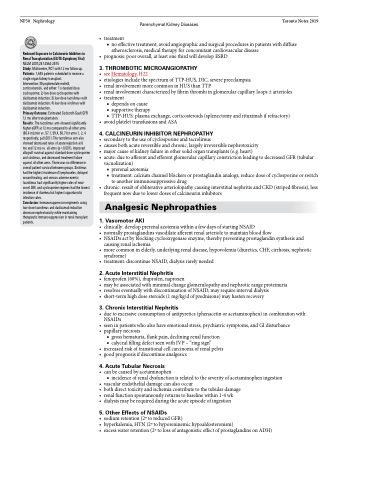Page 730 - TNFlipTest
P. 730
NP30 Nephrology
Parenchymal Kidney Diseases Toronto Notes 2019
• treatment
■ no effective treatment; avoid angiographic and surgical procedures in patients with diffuse
atherosclerosis, medical therapy for concomitant cardiovascular disease • prognosis:pooroverall,atleastonethirdwilldevelopESRD
3 . THROMBOTIC MICROANGIOPATHY
• seeHematology,H22
• etiologiesincludethespectrumofTTP-HUS,DIC,severepreeclampsia
• renalinvolvementmorecommoninHUSthanTTP
• renalinvolvementcharacterizedbyfibrinthrombiinglomerularcapillaryloops±arterioles • treatment
■ depends on cause
■ supportive therapy
■ TTP-HUS: plasma exchange, corticosteroids (splenectomy and rituximab if refractory)
• avoidplatelettransfusionsandASA
4 . CALCINEURIN INHIBITOR NEPHROPATHY
• secondarytotheuseofcyclosporineandtacrolimus
• causesbothacutereversibleandchronic,largelyirreversiblenephrotoxicity
• majorcauseofkidneyfailureinothersolidorgantransplants(e.g.heart)
• acute: due to afferent and efferent glomerular capillary constriction leading to decreased GFR (tubular
vacuolization)
■ prerenal azotemia
■ treatment: calcium channel blockers or prostaglandin analogs, reduce dose of cyclosporine or switch
to another immunosuppressive drug
• chronic: result of obliterative arteriolopathy causing interstitial nephritis and CKD (striped fibrosis), less
frequent now due to lower doses of calcineurin inhibitors
Analgesic Nephropathies
1 . Vasomotor AKI
• clinically:developprerenalazotemiawithinafewdaysofstartingNSAID
• normallyprostaglandinsvasodilateafferentrenalarterioletomaintainbloodflow
• NSAIDsactbyblockingcyclooxygenaseenzyme,therebypreventingprostaglandinsynthesisand
causing renal ischemia
• morecommoninelderly,underlyingrenaldisease,hypovolemia(diuretics,CHF,cirrhosis,nephrotic
syndrome)
• treatment:discontinueNSAID,dialysisrarelyneeded
2 . Acute Interstitial Nephritis
• fenoprofen(60%),ibuprofen,naproxen
• maybeassociatedwithminimalchangeglomerulopathyandnephroticrangeproteinuria • resolveseventuallywithdiscontinuationofNSAID,mayrequireintervaldialysis
• short-termhighdosesteroids(1mg/kg/dofprednisone)mayhastenrecovery
3 . Chronic Interstitial Nephritis
• duetoexcessiveconsumptionofantipyretics(phenacetinoracetaminophen)incombinationwith NSAIDs
• seeninpatientswhoalsohaveemotionalstress,psychiatricsymptoms,andGIdisturbance
• papillarynecrosis
■ gross hematuria, flank pain, declining renal function
■ calyceal filling defect seen with IVP – “ring sign”
• increasedriskoftransitionalcellcarcinomaofrenalpelvis
• goodprognosisifdiscontinueanalgesics
4 . Acute Tubular Necrosis
• canbecausedbyacetaminophen
■ incidence of renal dysfunction is related to the severity of acetaminophen ingestion
• vascularendothelialdamagecanalsooccur
• bothdirecttoxicityandischemiacontributetothetubulardamage • renalfunctionspontaneouslyreturnstobaselinewithin1-4wk
• dialysismayberequiredduringtheacuteepisodeofingestion
5 . Other Effects of NSAIDs
• sodiumretention(2otoreducedGFR)
• hyperkalemia,HTN(2otohyporeninemichypoaldosteronism)
• excesswaterretention(2otolossofantagonisticeffectofprostaglandinsonADH)
Reduced Exposure to Calcineurin Inhibitors in Renal Transplantation (ELITE-Symphony Trial) NEJM 2007;257:2562-2575
Study: Multicentre, RCT with 12 mo follow-up. Patients: 1,645 patients scheduled to receive a single organ kidney transplant.
Intervention: Mycophenolate mofetil, corticosteroids, and either: 1) standard dose cyclosporine; 2) low dose cyclosporine with daclizumab induction; 3) low dose tacrolimus with daclizumab induction; 4) low dose sirolimus with daclizumab induction.
Primary Outcome: Estimated Cockcroft-Gault GFR 12 mo after transplantation.
Results: The tacrolimus arm showed significantly higher eGFR at 12 mo compared to all other arms (65.4 mL/min vs. 57.1, 59.4, 56.7 for arms 1, 2, 4 respectively, p≤0.001). The tacrolimus arm also showed decreased rates of acute rejection at 6
mo and 12 mo vs. all arms (p<0.001), improved allograft survival against standard dose cyclosporine and sirolimus, and decreased treatment failure against all other arms. There was no difference in overall patient survival between groups. Sirolimus had the highest incidence of lymphoceles, delayed wound healing, and serious adverse events; tacrolimus had significantly higher rates of new- onset DM; and cyclosporine regimes had the lowest incidence of diarrhea but highest opportunistic infection rates.
Conclusion: Immunosuppression regiments using low dose tacrolimus and daclizumab induction decrease nephrotoxicity while maintaining therapeutic immunosuppression in renal transplant patients.


